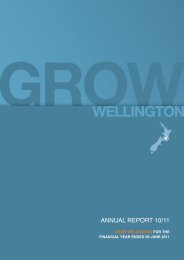OUTLOOK - Grow Wellington
OUTLOOK - Grow Wellington
OUTLOOK - Grow Wellington
Create successful ePaper yourself
Turn your PDF publications into a flip-book with our unique Google optimized e-Paper software.
12Tourism sector33Table 12.1 summarises the contribution of the tourismsector to the <strong>Wellington</strong> and New Zealand economies.The contribution of tourism to the local economy comesfrom three sources: tourism-characteristic industries, such asaccommodation, restaurants, transport services, and culturaland recreational services; tourism-related industries, specificallythe retail trade; and all other industries, including everything frompolice services to mining.The direct contribution of tourism in <strong>Wellington</strong> included theemployment of almost 13,000 FTEs, or 5.9% of all employment.The sector produced 4.7% of GDP, through almost 2,600 businesses.The <strong>Wellington</strong> region’s growing importance as a tourismdestination has seen its share of national tourism employmentrise slightly, to 11% in 2007. This figure is fast-approaching theproportion of total New Zealand employment based in <strong>Wellington</strong>,which currently stands at 11.9%.Table 12.2 presents the performance of the tourism sector in the<strong>Wellington</strong> region relative to its performance across New Zealand.The tourism sector in <strong>Wellington</strong> enjoyed strong growth in 2007,adding more than 300 new FTEs, at a rate of 2.6%. Similarly,the number of businesses in the region directly attributable totourism rose by 1.1%. The long-term figures, in which local tourismemployment growth averaged 1.8%, mask a decade of two halves.Tourism employment in the region grew 3.2% per annumover the three years to 2007, compared to an averageof 1.2% across the seven previous years.Table 12.3 shows the largest sub-industries by FTEs. 11As would be expected, the café, restaurant andaccommodation sector dominates tourism employment.The role of government in the region ensures that it also makesthe list of the top ten sub-industries in tourism by employment.12.1 Other Tourism IndicatorsTable 12.4 presents a range of additional tourism indicatorsfor the <strong>Wellington</strong> region and New Zealand.The stand-out figure for the region is the strong increasein guest nights achieved over the last two years (10.2% per year).The last year was particularly good, with guest nights up by360,000, or 14.5%, on 2006.While occupancy rates in the region have remained relativelyconstant over the last two years, this has been the result ofthe increase in the number of stay nights matching the risein capacity, a fact borne out by the numbers in the table. Thenumbers of accommodation establishments, capacity, and staynights have all increased at a rate faster than that seen nationally.Table 12.1 Tourism: summaryTourism FTEs % GDP ($2007m) % Business units %Tourism-Characteristic Industries 7,003 3.2% 416.1 1.9% 1,223 2.4%Tourism-Related Industries 2,274 1.0% 114.4 0.5% 489 1.0%All Non-Tourism-Related Industries 3,703 1.7% 466.8 2.2% 869 1.7%<strong>Wellington</strong> Region 12,981 5.9% 997.3 4.7% 2,581 5.1%New Zealand 117,875 6.4% 8,759.1 5.3% 25,666 5.1%Source: BERL Regional Database, Statistics NZ, Tourism Satellite Account11Industry names (at the 477-industry level) are those used in the Australia New Zealand Standard Industrial Classification (ANZSIC) New Zealand version, as published by StatisticsNew Zealand. It is important to note that these figures are not total figures for each sub-industry, but rather the proportion of each sub-industry estimated to be directly involved in tourism.




